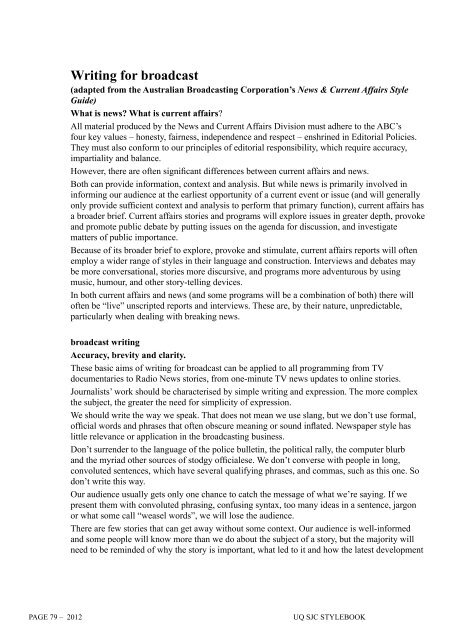Create successful ePaper yourself
Turn your PDF publications into a flip-book with our unique Google optimized e-Paper software.
Writing for broadcast(adapted from the Australian Broadcasting Corporation’s News & Current Affairs StyleGuide)What is news? What is current affairs?All material produced by the News <strong>and</strong> Current Affairs Division must adhere to the ABC’sfour key values – honesty, fairness, independence <strong>and</strong> respect – enshrined in Editorial Policies.They must also conform to our principles of editorial responsibility, which require accuracy,impartiality <strong>and</strong> balance.However, there are often significant differences between current affairs <strong>and</strong> news.Both can provide information, context <strong>and</strong> analysis. But while news is primarily involved ininforming our audience at the earliest opportunity of a current event or issue (<strong>and</strong> will generallyonly provide sufficient context <strong>and</strong> analysis to perform that primary function), current affairs hasa broader brief. Current affairs stories <strong>and</strong> programs will explore issues in greater depth, provoke<strong>and</strong> promote public debate by putting issues on the agenda for discussion, <strong>and</strong> investigatematters of public importance.Because of its broader brief to explore, provoke <strong>and</strong> stimulate, current affairs reports will oftenemploy a wider range of <strong>style</strong>s in their language <strong>and</strong> construction. Interviews <strong>and</strong> debates maybe more conversational, stories more discursive, <strong>and</strong> programs more adventurous by usingmusic, humour, <strong>and</strong> other story-telling devices.In both current affairs <strong>and</strong> news (<strong>and</strong> some programs will be a combination of both) there willoften be “live” unscripted reports <strong>and</strong> interviews. These are, by their nature, unpredictable,particularly when dealing with breaking news.broadcast writingAccuracy, brevity <strong>and</strong> clarity.These basic aims of writing for broadcast can be applied to all programming from TVdocumentaries to Radio News stories, from one-minute TV news updates to online stories.Journalists’ work should be characterised by simple writing <strong>and</strong> expression. The more complexthe subject, the greater the need for simplicity of expression.We should write the way we speak. That does not mean we use slang, but we don’t use formal,official words <strong>and</strong> phrases that often obscure meaning or sound inflated. Newspaper <strong>style</strong> haslittle relevance or application in the broadcasting business.Don’t surrender to the language of the police bulletin, the political rally, the computer blurb<strong>and</strong> the myriad other sources of stodgy officialese. We don’t converse with people in long,convoluted sentences, which have several qualifying phrases, <strong>and</strong> commas, such as this one. Sodon’t write this way.Our audience usually gets only one chance to catch the message of what we’re saying. If wepresent them with convoluted phrasing, confusing syntax, too many ideas in a sentence, jargonor what some call “weasel words”, we will lose the audience.There are few stories that can get away without some context. Our audience is well-informed<strong>and</strong> some people will know more than we do about the subject of a story, but the majority willneed to be reminded of why the story is important, what led to it <strong>and</strong> how the latest developmentPAGE 79 – <strong>2012</strong>UQ <strong>SJC</strong> STYLEBOOK


